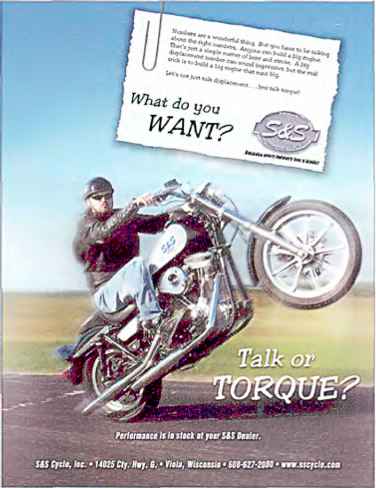Market Follower Strategies
Some years ago, i heodore Levitt wrote an article emitled "Innovative Imitation." in which lie argued that a strategy of product imitation might be as profitable as a straiegy of product innovation.tflThe innovator bears the expense of developing the new product.
getting it into distribution. and informing and educating the market, '['lie reward for nil this work and risk is normally market leaders hip. However, another firm can come along and copy or Improve tin the new product. Although it probably WlU not overtake die leader, the follower can achieve high profits because il did not beat any of (he innovation expense.
S&S Cycle is me biggest supplier of complété engines and major motor parts to more than IS companies that build several thousand Harley-like cruiser bikes each year. These doners charge as much as S3Q.0Q0 for ir.eir customized creations. ESS has built its name by improving on Hartey-Davidson's handiwork, tts customers are olten would-be Karley buyers frustrated by long wailing tires at the dealers. Other customers simply want the incredibly powerful S&S engines. S&S stays abreast of its evolving market by ordering a new rlarley bfltf every ■ year and taking apart the engine to see what il can improve upon."19
Many companies prefer to follow rather than challenge lilt market leader. Patterns of "conscious parallelism" are com mon in capita!-intensive, ho ningencous-product industries, such as steel, fertilisers, and chemicals. The opportunities for product differentiation and Image differentiation are low: service quality is often comparable; and [nice sensitivity runs high. The mood in these industries is against short-run grabs for market share because that strategy only provokes retaliation. Most firms decide against stealing one anotliers' customers. Instead, they present similar offers to buyers, usually by copying the leader. Market shares show high si ability.
This is not tn say that market followers lack strategies. A market follower must know how to hold current customers and win a fair share of new customers. Each follower tries to bring distinctive advantages to its target market—location, services, financing. Because ihe follower is often a major target of attack by challengers, it must keep jt5 manufacturing costs low and ils product quality and services high. It must also enter new markets ¡is they open up. The follower has to dehne a growth path, bin one that does not invite competitive retaliation. l our broad strategies can he distinguished:
I, Counterfeiter-The com iter fei ter du plica te s the leader's product and package and sells it on the black market or through disreputable dealers. Music record firms, Apple Computer, and 1 to lev have been plagued with the counterfeiter problem, especially in Asia.
Atlam Morgan otters eight suggestions on how sman brands can better compele:
Atlam Morgan otters eight suggestions on how sman brands can better compele:
1. Break Willi your immediate past— Don t Lie afraid to ask "dumb' quest«™ to cha^'eage convention and view your hrand dil'erently,
2. Build a "lighthouse identity"— Esljljl sh values and communicate who and wily you are (e.Q., Apple).
3. Assume thought leadership of the category- Break convention in lenns of nepresen'ation (*vhat you say itout yomseifi. wtnone you gay il (medium), ami experience fwliat ytiu rio beyond tafy
A. Create symbols of raeivaluation —A rochet uses half of its fuel n Ihe first mite lo txeak tap from ihe gravitational pul'—ypu may need to [rtiarite people.
5, Sacrifice— Foclis your target, message, reach and frequency, dstnbulicn, and line extensions and recognize thai less can üe more.
G. Overcontmit- Although you may tto fewer things, tfo 'big thirtgs when you do Ihem,
7. Use publicity and advertising to enter popular culture—
Unconventional ttnffnunicationa can get people talking. Be rtteii-ee/rfer.eii, not consumer-centered— Susta n challenger momentum by na losing sighi ol what Ihe orand is about and can lie. and redefine marketing support and 1he Center of the company to rellecl this vision.
St«:?.-¿dam Mtfgan, Fa,1.'«? itx> fogf/sii: Mew Chuseogar Brands £ärr Compete Ag&nslßr&xl Leaders fltew York: Jonn Wiley £ Sons, lMy..

Mattel foitower strateg fa S&S Cyc i supplies engines aril pans to contpaniei lhat DuiSil Harley-f^idSMl clones, has a reputation (or building powefHil cng lies llial improve on the Hai .sy produce
2. doner - The clutter emu tales the leader's products, name, at id packaging, '.villi slight variations. For example, Ralcorp Holding Inc., sells imitations of name-brand cereals in tonka I ike boxes. Its Tasteeos. Fruit Rings, and Corn Hakes sell for nearly SI a box less I [Km [tie leading name brands.
3. fiiif/rtior-The imitator copies some things from the leader but maintains differentiation in terms of packaging, advertising pricing, or location- The leader does not mind the Imitator as long as the imitator does not attack the leader aggressively. Fernandez Pujals grew up in Tort Lauderdale, Florida, and took Domino's home delivery idea to Spain, where lie borrowed S!W,000 to Open his first store in Madrid. His TelePizza chain now operates almost 1,000 stores in Europe a ltd I .a tin America.
-I. Adapter-Thb adapter takes the Leader's products and adapts or improves them. ; he adapter may choose to sell to different markets, but often the adapter grows into the hitnre challenger, as many lapanesc firms have done after adapting .and improving products developed elsewhere.
What docs a follower earn? Normally, less than the leader. lror example, a study of food-processing companies showed die largest firm averaging a 16 percent return on investmetii: the number-two firm, G percent; the number-three firm, -1 percent, and the number-four firm, ti percent, tn this case, only the top two firms have profits. No Wonder Jack Welch, former C1;0 ofGE, told his business units that each must reach the number-one or - two position in its market or else I Follcwership is often not a rewarding path.
Continue reading here: Product Line Length
Was this article helpful?